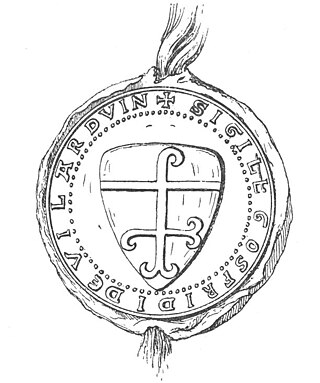Related Research Articles

The Principality of Achaea or Principality of Morea was one of the vassal states of the Latin Empire, which replaced the Byzantine Empire after the capture of Constantinople during the Fourth Crusade. It became a vassal of the Kingdom of Thessalonica, along with the Duchy of Athens, until Thessalonica was captured by Epirus in 1224. After this, Achaea became the dominant power in Greece, lasting continuously for 227 years and cumulatively for 229.

The Villehardouin family was a noble dynasty that originated in Villehardouin, a former commune of the Aube department, now part of Val-d'Auzon, France. It is most notable as the ruling house of the Principality of Achaea, a Frankish crusader state in the Peloponnese peninsula of Greece, between 1209 and 1278, when possession passed to the Angevin Kings of Naples.

Geoffrey I of Villehardouin was a French knight from the County of Champagne who joined the Fourth Crusade. He participated in the conquest of the Peloponnese and became the second prince of Achaea.

Louis of Burgundy was a member of the Capetian House of Burgundy who ruled the Principality of Achaea and claimed the defunct Kingdom of Thessalonica.

Isabella de la Roche was a daughter of Guy I de la Roche. She was married twice, firstly to Geoffrey of Briel, Lord of Karytaina and then secondly to Hugh, Count of Brienne, having children only with her second husband.
John Chauderon was the Baron of Estamira and Grand Constable of the Principality of Achaea, the strongest of the principalities of Frankish Greece.

The Barony of Akova was a medieval Frankish fiefdom of the Principality of Achaea, located in the mountains of eastern Elis in the Peloponnese peninsula in Greece, centred on the fortress of Akova or Mattegrifon. It was among the twelve original baronies of Achaea, but was conquered by the Byzantines in 1320.

The Barony of Passavant or Passava was a medieval Frankish fiefdom of the Principality of Achaea, located in the mountains between the Mani peninsula and the plain of Laconia, in the Peloponnese peninsula in Greece, centred on the fortress of Passavant or Passava. It was among the twelve original baronies of the Principality of Achaea, but was conquered by the Byzantines in the early 1260s.

The Barony of Karytaina or of Skorta was a medieval Frankish fiefdom of the Principality of Achaea, located in the Peloponnese peninsula in Greece, centred on the town of Karytaina in the mountainous region known as Skorta.
Vilain of Aulnay was a French knight from Aulnay-l'Aître in the Champagne who became marshal of the Latin Empire of Constantinople and first Baron of Arcadia in the Principality of Achaea. In the Greek version of the Chronicle of the Morea, he is attested as Βηλὲς ντὲ Ἀνόε, a form which passed to the other versions of the Chronicle as Anoé, Annoée or Anoée.

The Barony of Estamira or Stamira was a medieval Frankish fiefdom of the Principality of Achaea, located in the fertile plains of the Elis region of the Peloponnese peninsula in Greece, and centred on the now vanished fortress of Estamira.
Geoffrey of Briel, in older literature Geoffrey of Bruyères, was a French knight and the third lord of the Barony of Karytaina in the Principality of Achaea, in Frankish Greece. He led a colourful and turbulent life, narrated in detail in the Chronicle of the Morea. Accounted the finest knight in the Principality, he fought in the wars against the Byzantine Greeks, was captured in the Battle of Pelagonia in 1259, and was sent back to Achaea bearing the Byzantine terms in 1261. Geoffrey was twice deprived of his barony, once for rebelling against his uncle, the Prince of Achaea William II of Villehardouin, and then for abandoning the Principality without leave in order to spend time with a mistress, the wife of one of his feudatories, in Italy. He was pardoned both times, but henceforth held his title as a gift of the Prince. He died childless in 1275, and the Barony of Karytaina was split up.
Margaret of Villehardouin was the daughter of William II of Villehardouin, Prince of Achaea, and his third wife Anna Komnene Doukaina.
Hugh of Briel, in older literature Hugh of Bruyères, was a French knight and the second lord of the Barony of Karytaina in the Principality of Achaea, in Frankish Greece.
Geoffrey II of Briel or Geoffrey of Briel the Younger, was a French knight and the cousin or nephew of Geoffrey I of Briel, Baron of Karytaina in the Principality of Achaea, in Frankish Greece.
Margaret, Lady of Lisarea was lady of the fief of Lisarea in the Principality of Achaea, around 1276.
John II of Nivelet is the name given in modern historiography to the last Baron of Nivelet in the Principality of Achaea, in Frankish Greece.
Renaud of Briel, in older literature Renaud of Bruyères, was a French knight and the first lord of the Barony of Karytaina in the Principality of Achaea, in Frankish Greece.
Geoffrey of Aulnay was Baron of Arcadia in the Principality of Achaea in the late 13th century.
Geoffrey Chauderon was the first Baron of Estamira and Grand Constable of the Principality of Achaea, in Frankish Greece.
References
- 1 2 Shawcross, Teresa (2009). The Chronicle of Morea, Historiography in Crusader Greece. Oxford University Press. p. 4.
- 1 2 Guérin, Marie (2014). Les dames de la Morée franque (XIIIe-XVe siècle) : Représentation, rôle et pouvoir des femmes de l’élite latine en Grèce médiévale. Université Paris-Sorbonne. p. 77.
- 1 2 Bon, Antoine (1969). La Morée franque; recherches historiques, topographiques et archéologiques sur la principauté d'Achaïe (1205-1430). p. 105.
- ↑ Dourou-Iliopoulou, Maria (2005). The Frankish Principality of Achaea (1204-1432), History, Organization, Society. Thessaloniki: Vanias. pp. 67–68. ISBN 960-288-153-4.